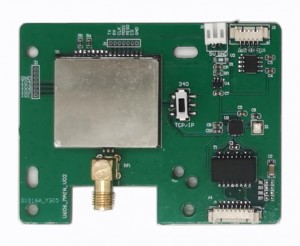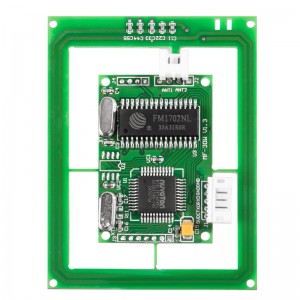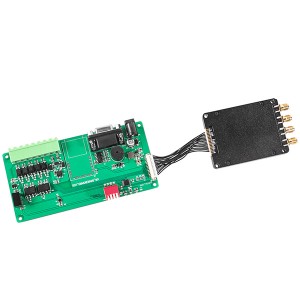RFID Development History
The foundation of RFID technology implementation is to use electromagnetic energy to achieve AIDC, which is a form of energy that exists in nature.
(1) People's understanding of electromagnetic energy
Tracing back to history, ancient Chinese people discovered and began using natural magnets to make guide cars. In modern times, more and more people are conducting in-depth observations and mathematical basic research on electricity, magnetism, and light, with the outstanding figure being American Benjamin Franklin. In 1846, British scientist Michelle Faraday discovered that both light and radio waves belong to electromagnetic energy. In 1864, Scottish scientist James Clark Maxwell published his theory of electromagnetic fields. In 1887, German scientist Henri Rudolf Hertz confirmed Maxwell's electromagnetic field theory and demonstrated that electromagnetic waves propagate at the speed of light and can be reflected, exhibiting polarization characteristics similar to light. Hertz's experiment was soon repeated by Russian scientist Alexander Pope. In 1896, Maximi successfully achieved the transatlantic telegraph, pioneering the use of electromagnetic energy to serve humanity. Furthermore, in 1922, radar was born. As an effective weapon for identifying enemy space objects (aircraft), radar played an important role in World War II, and radar technology also made great progress. Until now, radar technology is still constantly developing, and people are developing high-performance radars for various purposes.
(2) The Development of RFID Technology
RFID directly inherits the concept of radar and has developed a vibrant new AIDC technology - RFID technology. In 1948, Harry Stockman's publication "Communication Using Reflective Power" laid the theoretical foundation for radio frequency identification (RFID).
1) The development history of RFID technology. In the 20th century, the theoretical and applied research of radio technology was one of the most important achievements in the development of science and technology. The development of RFID technology can be divided into the following 10-year periods:
1941-1950. The improvement and application of radar gave birth to RFID technology, which laid the theoretical foundation in 1948.
1951-1960. The early exploration stage of RFID technology was mainly in laboratory experimental research.
1961-1970. The theory of RFID technology has been developed and some application attempts have begun.
1971-1980. RFID technology and product development are in a period of great development, and various RFID technology tests are being accelerated. Some of the earliest RFID applications have emerged.
1981-1990. RFID technology and products have entered the commercial application stage, and various scale applications have begun to emerge.
From 1991 to 2000. The standardization of RFID technology is receiving increasing attention, and RFID products are widely adopted, gradually becoming a part of people's lives.
2001 present. The issue of standardization is increasingly being valued by people, and the variety of RFID products is becoming more diverse, with active electronic tags
Both passive and semi passive electronic tags have been developed, with the cost of electronic tags continuously decreasing and the scale of application in the industry expanding.
The theory of RFID technology has been enriched and improved. Single chip electronic tags, multi electronic tag recognition, wireless readable and writable, remote recognition of passive electronic tags, and RFID adapted to high-speed moving objects are becoming a reality.
2) The development status of RFID technology both domestically and internationally.
The development of RFID technology is relatively early and fast in foreign countries. Especially in the United States, the United Kingdom, Germany, Sweden, Switzerland, Japan, and South Africa, there are currently mature and advanced RFID systems.
Among them, low-frequency close range RFID systems are mainly concentrated in 125kHz and 13.56MHz systems; High frequency long-distance RFID
The system is mainly concentrated in the UHF frequency band (902MHz -928MHz) at 915MHz, 2.45GHz, and 5.8GHz. The long-distance RFID system in the UHF frequency band has been well developed in North America; Active 2.45GHz systems have been widely used in European applications. The 5.8GHz system has mature active RFID systems in both Japan and Europe.
In the first 10 years of RFID technology development, discussions on international standards related to RFID technology were unprecedentedly enthusiastic. The SC31 sub committee of the ISO/IEC Joint Technical Committee JTCl of the International Organization for Standardization established the RFID Standardization Research Working Group WG4. Especially with the establishment of the Auto ID Center non-profit organization on October 1, 1999, initiated by MIT at the Massachusetts Institute of Technology in the United States, its role in regulating RFID applications will become increasingly evident. Based on the research on RFID theory, technology, and applications, Auto-ID Center has made the following main contributions:
a. Propose the concept of Electronic Product Code (EPC) and its format planning. This has laid the foundation for reducing the functional design of electronic tag chips, lowering the cost of electronic tags, and expanding the application field of RFID.
b. The concept and architecture of physical internet have been proposed, building a bridge for EPC to enter the internet.
c. We have established an open international public technology research platform for the application of automatic identification technology, which has created conditions for promoting the standardization research of low-cost RFID tags and readers.
China has also developed rapidly in the research of RFID technology, and the market cultivation has begun to bear fruit. A typical example is the introduction of a long-distance automatic identification system with fully independent intellectual property rights in the construction of China's railway automatic identification system.
The research on China's railway automatic identification system has officially started, and can be traced back to the national/K2/~plan. The Ministry of Railways once listed the project of automatic recording of train numbers for freight cars as a key research topic for the Eighth Five Year Plan. In the mid-1990s, multiple research institutions in China participated in the research of this technology, explored various implementation solutions, and ultimately determined RFID technology as the best solution for automatic tracking of truck numbers. Furthermore, in terms of RFID implementation technology, active tag schemes and passive tag frequency doubling schemes have been explored. Finally, the passive tag RFID scheme was selected. After years of on-site operation testing, the railway car number automatic recognition system project was fully put into construction in 1999. After about two years of construction and trial operation, the railway car number automatic recognition system engineering has played a system design function, fulfilling the dreams of railway people, and its radiation and penetration into other applications are becoming increasingly apparent.
In terms of close range RFID applications, many cities have implemented bus RF cards as prepaid electronic ticket applications, prepaid electronic meal cards, etc.
In terms of RFID technology research and product development, China has the technical ability and system integration ability to independently develop low-frequency, high-frequency, and microwave RFID electronic tags and readers. The gap between advanced RFID technology and foreign countries is mainly reflected in RFID chip technology. However, in terms of tag chip design and development, multiple successful low-frequency RFID system tag chips have been launched in China





















